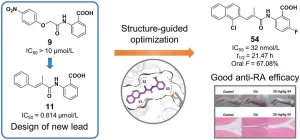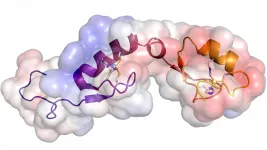(Press-News.org) It's like something out of science fiction. Research led by Bigelow Laboratory for Ocean Sciences has revealed that a group of microbes, which feed off chemical reactions triggered by radioactivity, have been at an evolutionary standstill for millions of years. The discovery could have significant implications for biotechnology applications and scientific understanding of microbial evolution.
"This discovery shows that we must be careful when making assumptions about the speed of evolution and how we interpret the tree of life," said Eric Becraft, the lead author on the paper. "It is possible that some organisms go into an evolutionary full-sprint, while others slow to a crawl, challenging the establishment of reliable molecular timelines."
Becraft, now an assistant professor of biology at the University of Northern Alabama, completed the research as part of his postdoctoral work at Bigelow Laboratory and recently published it in the Nature publishing group's ISME Journal.
The microbe, Candidatus Desulforudis audaxviator, was first discovered in 2008 by a team of scientists, led by Tullis Onstott, a co-author on the new study. Found in a South African gold mine almost two miles beneath the Earth's surface, the microbes acquire the energy they need from chemical reactions caused by the natural radioactive decay in minerals. They inhabit water-filled cavities inside rocks in a completely independent ecosystem, free from reliance on sunlight or any other organisms.
Because of their unique biology and isolation, the authors of the new study wanted to understand how the microbes evolved. They searched other environmental samples from deep underground and discovered Candidatus Desulforudis audaxviator in Siberia and California, as well as in several additional mines in South Africa. Since each environment was chemically different, these discoveries gave the researchers a unique opportunity to look for differences that have emerged between the populations over their millions of years of evolution.
"We wanted to use that information to understand how they evolved and what kind of environmental conditions lead to what kind of genetic adaptations," said Bigelow Laboratory Senior Research Scientist Ramunas Stepanauskas, the corresponding author on the paper and Becraft's postdoctoral advisor. "We thought of the microbes as though they were inhabitants of isolated islands, like the finches that Darwin studied in the Galapagos."
Using advanced tools that allow scientists to read the genetic blueprints of individual cells, the researchers examined the genomes of 126 microbes obtained from three continents. Surprisingly, they all turned out to be almost identical.
"It was shocking," Stepanauskas said. "They had the same makeup, and so we started scratching our heads."
Scientists found no evidence that the microbes can travel long distances, survive on the surface, or live long in the presence of oxygen. So, once researchers determined that there was no possibility the samples were cross-contaminated during research, plausible explanations dwindled.
"The best explanation we have at the moment is that these microbes did not change much since their physical locations separated during the breakup of supercontinent Pangaea, about 175 million years ago," Stepanauskas said. "They appear to be living fossils from those days. That sounds quite crazy and goes against the contemporary understanding of microbial evolution."
What this means for the pace of microbial evolution, which often happens at a much more accelerated rate, is surprising. Many well-studied bacteria, such as E. coli, have been found to evolve in only a few years in response to environmental changes, such as exposure to antibiotics.
Stepanauskas and his colleagues hypothesize the standstill evolution they discovered is due to the microbe's powerful protections against mutation, which have essentially locked their genetic code. If the researchers are correct, this would be a rare feature with potentially valuable benefits.
Microbial enzymes that create copies of DNA molecules, called DNA polymerases, are widely used in biotechnology. Enzymes with high fidelity, or the ability to recreate themselves with little differences between the copy and the original, are especially valuable.
"There's a high demand for DNA polymerases that don't make many mistakes," Stepanauskas said. "Such enzymes may be useful for DNA sequencing, diagnostic tests, and gene therapy."
Beyond potential applications, the results of this study could have far-reaching implications and change the way scientists think about microbial genetics and the pace of their evolution.
"These findings are a powerful reminder that the various microbial branches we observe on the tree of life may differ vastly in the time since their last common ancestor," Becraft said. "Understanding this is critical to understanding the history of life on Earth."
INFORMATION:
Bigelow Laboratory for Ocean Sciences is an independent, nonprofit research institute located in East Boothbay, Maine. From the Arctic to the Antarctic, Bigelow Laboratory scientists use innovative approaches to study the foundation of global ocean health and unlock its potential to improve the future for all life on the planet. Learn more at bigelow.org, and join the conversation on Facebook, Instagram, and Twitter.
Design, synthesis, molecular modeling, and biological evaluation of acrylamide derivatives as potent inhibitors of human dihydroorotate dehydrogenase for the treatment of rheumatoid arthritis
Human dihydroorotate dehydrogenase (DHODH) is a viable target for the development of therapeutics to treat cancer and immunological diseases, such as rheumatoid arthritis (RA), psoriasis and multiple sclerosis (MS).
The authors designed and synthesized a series of acrylamide-based novel DHODH inhibitors as potential RA treatment agents. 2-Acrylamidobenzoic acid analog 11 was identified as the lead compound for structure-activity ...
Orchids of the Boreal zone are rare species. Most of the 28,000 species of the Orchid family actually live in the tropics. In the Boreal zone, ground orchids can hardly tolerate competition from other plants -- mainly forbs or grasses. So they are often pushed into ecotones -- border areas between meadows and forests, or between forests and swamps.
Furthermore, there has been a decline in wild orchids all over North America and Eurasia, caused in part by human-induced destruction of their habitats, the transformation of ecosystems, and the harvesting of flowers from the wild.
In the Novosibirsk region, ...
Pioneering research led by experts from the University of Exeter's Living Systems Institute has provided new insight into formation of the human embryo.
The team of researchers discovered an unique regenerative property of cells in the early human embryo.
The first tissue to form in the embryo of mammals is the trophectoderm, which goes on to connect with the uterus and make the placenta. Previous research in mice found that trophectoderm is only made once.
In the new study, however, the research team found that human early embryos are able to regenerate trophectoderm. They also showed that human embryonic stem cells grown in the laboratory can similarly ...
Every year, our planet encounters dust from comets and asteroids. These interplanetary dust particles pass through our atmosphere and give rise to shooting stars. Some of them reach the ground in the form of micrometeorites. An international program conducted for nearly 20 years by scientists from the CNRS, the Université Paris-Saclay and the National museum of natural history with the support of the French polar institute, has determined that 5,200 tons per year of these micrometeorites reach the ground. The study will be available in the journal Earth & Planetary Science Letters from April 15.
Micrometeorites have always fallen on our planet. These interplanetary dust particles from comets or asteroids are particles of a few tenths to hundredths of a millimetre that have passed ...
Scientists have made a pivotal breakthrough in understanding the way in which cells communicate with each other.
A team of international researchers, including experts from the University of Exeter's Living Systems Institute, has identified how signalling pathways of Wnt proteins - which orchestrate and control many cell developmental processes - operate on both molecular and cellular levels.
Various mechanisms exist for cells to communicate with each other, and many are essential for development. This information exchange between cells is often based on signalling proteins that activate specific intracellular signalling cascades to control cell behaviour at a distance.
Wnt proteins are produced by a relatively small group ...
The damaging effects of life under Nazi rule have long been known with many victims having experienced periods of protracted emotional and physical torture, malnutrition and mass exposure to disease. But recent research from the Hebrew University of Jerusalem show that even for those who survived, their health and mortality continued to be directly impacted long after the end of the Holocaust.
The study, led by Drs. Iaroslav Youssim and Hagit Hochner from the School of Public Health at the Faculty of Medicine and published in the American Journal of Epidemiology, investigated mortality rates from ...
Short pieces of DNA--jumping genes--can bounce from one place to another in our genomes. When too many DNA fragments move around, cancer, infertility, and other problems can arise. Cold Spring Harbor Laboratory (CSHL) Professor & HHMI Investigator Leemor Joshua-Tor and a research investigator in her lab, Jonathan Ipsaro, study how cells safeguard the genome's integrity and immobilize these restless bits of DNA. They found that one of the jumping genes' most needed resources may also be their greatest vulnerability.
The mammalian genome is full of genetic elements that have the potential to move from place to place. One type is an LTR retrotransposon (LTR). In normal cells, these elements don't ...
ITHACA, N.Y. - Research shows people turn to religion in times of fear and uncertainty - and March 2020 was one of those times.
To find the impact of religion during the early days of the COVID-19 pandemic in the United States, Landon Schnabel, the Robert and Ann Rosenthal Assistant Professor of Sociology in the College of Arts and Sciences, analyzed responses from 11,537 Americans surveyed March 19-24, 2020, shortly after the World Health Organization declared COVID-19 a global health pandemic.
Religion protected mental health of members of several ...
Image inpainting is a computer vision technique in which pixels missing from an image are filled in. It is often used to remove unwanted objects from an image or to recreate missing regions of occluded images. Inpainting is a common tool for predicting missing image data, but it's challenging to synthesize the missing pixels in a realistic and coherent way.
Researchers at the University of Tokyo have presented a frequency-based inpainting method that enables the use of both frequency and spatial information to generate missing image portions. Publishing in the Journal of Electronic Imaging (JEI), Hiya Roy et al. detail the technique in " END ...
COLUMBUS, Ohio - It's one thing to decide among two or three snacks available at a friend's house. But what do people do when they're faced with a vending machine offering 36 different options?
A new study using eye-tracking technology suggests that the amount of time people spend looking at individual items may actually help them decide. Findings showed that people tended to choose snacks they spent more time looking at, sometimes even over snacks that they rated more highly.
"We could do pretty well predicting what people would choose based just ...





